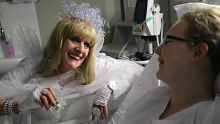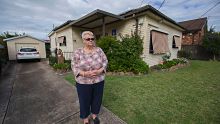The early red-light district of Melbourne was much like today's St Kilda, archaeologists say.
The historically significant "Little Lon" precinct in the east of Melbourne's CBD – covering Little Lonsdale, Spring, Exhibition and Lonsdale streets – has been investigated by archaeologists for almost three decades.
More iPad Videos
Melbourne's 'Little Lon' precinct unearthed
Thousands of artefacts are discovered in one of the most significant archaeological digs in Melbourne's history.
Their searches have uncovered pocket watches, bottles, pins, Chinese coins, contraceptive devices (bone rings that would have been used as part of a diaphragm) and clay tobacco pipes with erotic designs that were most probably used by brothel patrons.
Most of the materials came from cesspits from the 1850s to the 1880s.
Jeremy Smith, principal archeologist at Heritage Victoria, said Little Lon was a "nighttime place and a daytime place" in the years after Melbourne's founding in 1835.
"I'm sort of mindful of Fitzroy Street in St Kilda, where if you go there during the day and in the early evening, it's trendy bars and all that sort of things," Mr Smith said.
"And if you go there later at night its character changes and the more insalubrious activity starts to take place.
"At Little Lon we have families and we have reputable business and we have immigrants, and we had this seedy underbelly too."

Mr Smith said the investigations had shown the "complexity" of life in the mid- to late-19th century.
"There was this sense that this was Melbourne's slum, it's Melbourne's red-light district," he said.

"[But] even people who were living in impoverished conditions ... individually some of them were spending money on things that were quite ornate, or they might have liked to have a bit of luxury to brighten up their day."
Another finding was that Little Lon was a "place of opportunity" for more reputable businesses and migrants from places such as China, India, Syria, France, Germany, the US and the British Isles. .

Mr Smith said the archaeological work was internationally significant.
"Even in Rome or Athens or London, it's really hard to find the archaeology of that very first phase of settlement, but we have it in Melbourne," he said.

"When I speak to overseas archeologists they all know Little Lon, they all know about this block, because it's so rare that an entire city area has been investigated in this detail."
Caitlin D'Gluyas, consultant at GML Heritage, which carried out the archaeological investigations, said the "interest to the public is probably the diversity of what life was like on that site before it was developed in the 20th century."

"It's just a completely different world that's buried beneath the site: the stables, tiny cottages, cesspits, all these kind of things can be found beneath the city."
The Little Lon site has been used continuously since 1847. In the 19th century it housed everything from a pub to a boarding house, small cottages, a factory, a mission hall to support destitute women, and a dance hall.
Archaeological work is largely finished and one portion of the site is under development by its owner, the property fund ISPT.
Reference to the site's history will be included in the new $75 million, 16-level office tower to be occupied by Australian Unity which is going up on the corner of Spring and Little Lonsdale streets.













0 comments
New User? Sign up